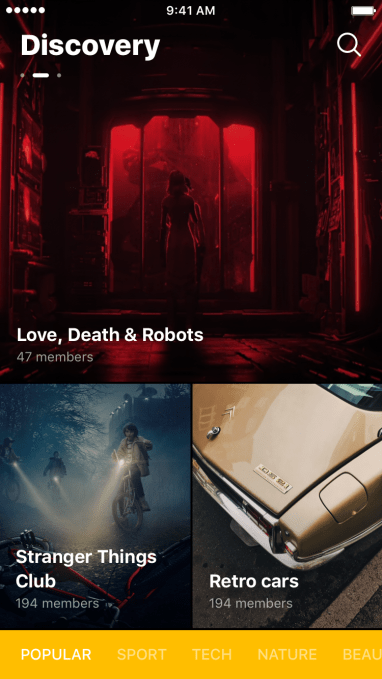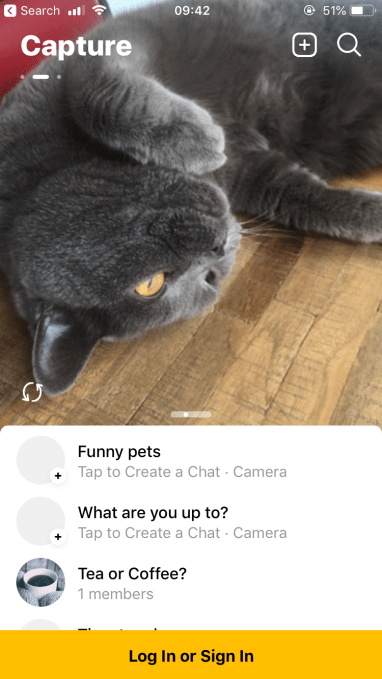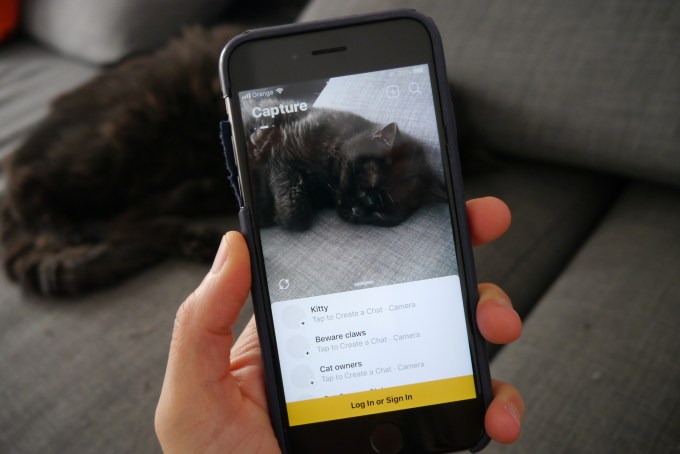At first glance launching a new social app may seem as sensible a startup idea as plunging headfirst into shark-infested waters. But with even infamous curtain-ripper Facebook now making grand claims about a ‘pivot to privacy’ it’s clear something is shifting in the commercial shipping channels that contain our digital chatter.
Whisper it: Feeds are tiring. Follows are tedious. Attention is expiring. There’s also, of course, the damage that personal digital baggage left out in the open can wreak long after the fact of a blown fuse or fleeting snap.
Public feeds have become vehicles of self-promotion; carefully and heavily curated — which of course brings its own peer pressures to keep up with friends’ lux exploits and the influencer ‘gram aesthetic that pretends life looks like a magazine spread.
Yet for a brief time, in the gritty early years of social media, there was something akin to spontaneous, confessional reality on show online. People do like to share. That’s mostly been swapped for the polish of aspirational faking it on apps like Facebook-owned Instagram. While genuine friend chatter has moved behind the quasi-closed doors of group messaging apps, like Facebook-owned WhatsApp (or rival Telegram).
If you want to chat more freely online without being defined by your existing social graph the options are less mainstream friendly to say the least.
Twitter is genuinely great if you’re willing to put in the time and effort to find interesting strangers. But its user growth problem shows most consumers just aren’t willing (or able) to do that. Telegram groups also require time and effort to track down.
Also relevant in interest-based chat: Veteran forum Reddit, and game chat platform Disqus — both pretty popular, though not in a way that really cuts across the mainstream, tending to cater to more niche and/or focused interests. Neither is designed for mobile first either.
This is why Capture’s founders are convinced there’s a timely opportunity for a new social app to slot in — one which leverages smartphone sensors and AI smarts to make chatting about anything as easy as pointing a camera to take a shot.
They’re not new to the social app game, either. As we reported last year, two of Capture’s founders were part of the team behind the style transfer app Prisma, which racked up tens of millions of downloads over a few viral months of 2016.
And with such a bright feather in their cap, a number of investors — led by General Catalyst — were unsurprisingly eager to chip into Capture’s $1M seed, setting them on the road to today’s launch.
Point and chat
“The main idea behind the app is during the day you’ve got different experiences — working, watching some TV series etc, you’re sitting in an arena watching some sports, or something like that. So we imagine that you should open the app during any type of experience you have during the day,” says Capture co-founder and CEO Alexey Moiseenkov fleshing out the overarching vision for the app.
“It’s not for your friends; it’s the moment when you should share something or just ask something or discuss something with other people. Like news, for example… I want to discuss news with the people who are relevant, who want to discuss it. And so on and on. So I imagine it is about small groups with the same goal, discussing the same experience, or something like that. It’s all about your everyday life.”
“Basically you can imagine our app as like real-time forum,” he adds. “Real-time social things like Reddit. So it’s more about live discussion, not postponing something.”
Chat(room) recommendations are based on contextual inferences that Capture can glean from the mobile hardware. Namely where you are (so the app needs access to your location) and even whether you’re on the move or lounging around (it also accesses the accelerometer so can tell the angle of the phone).
The primary sensory input comes from the camera of course. So like Snap it’s a camera-first app, opening straight into the rear lens’ live view.
By default chats in Capture are public so it also knows what topics users are discussing — which in turn further feeds and hones its recommendations for chats (and indeed matching users).
Co-founder and CMO Aram Hardy (also formerly at Prisma) gives the example of the free-flowing discussion you can see unrolling in YouTube comments when a movie trailer gets its first release — as the sort of energetic, expressive discussion Capture wants to channel inside its app.
“It’s exploding,” he says. “People are throwing those comments, discussing it on YouTube, on web, and that’s a real pain because there is no tool where you can simply discuss it with people, maybe with people around you, who are just interested in this particular trailer live on a mobile device — that’s a real pain.”
“Everything which is happening around the person should be taken into consideration to be suggested in Capture — that’s our simple vision,” he adds.
Everything will mean pop culture, news, local events and interest-based communities.
Though some of the relevant sources of pop/events content aren’t yet live in the app. But the plan is to keep bulking out the suggestive mix to expand what can be discovered via chat suggestions. (There’s also a discovery tab to surface public chats.)

Hardy even envisages Capture being able to point users to an unfolding accident in their area — which could generate a spontaneous need for locals or passers by to share information.
The aim for the app — which is launching on iOS today (Android will come later; maybe by fall) — is to provide an ever ready, almost no-barrier-to-entry chat channel that offers mobile users no-strings-attached socializing free from the pressures (and limits) of existing social graphs/friend networks; as well as being a context-savvy aid for content and event discovery, which means helping people dive into relevant discussion communities based on shared interests and/or proximity.
Of course location-based chatting is hardly a new idea. (And messaging giant Telegram just added a location-based chats feature to its platform.)
But the team’s premise is that mobile users are now looking for smart ways to supplement their social graph — and it’s betting on a savvy interface unlocking and (re)channelling underserved demand.
“People are really tired of something really follower based,” argues Moiseenkov. “All this stuff with a following, liking and so on. I feel there is a huge opportunity for all the companies around the world to make something based on real-time communication. It’s more like you will be heard in this chat so you can’t miss a thing. And I think that’s a powerful shot.
“We want to create a smaller room for every community in the Internet… So you can always join any group and just start talking in a free way. So you never shared your real identity — or it’s under your control. You can share or not, it’s up to you. And I think we need that.
“It’s what we miss during this Facebook age where everybody is ‘real’. Imagine that it’s like a game. In a game you’re really free — you can express yourself what way you want. I think that’s a great idea.”
“The entry threshold [for Twitter] is enormous,” adds Hardy. “You can’t have an account on Twitter and get famous within a week if you’re not an influencer. If you’re a simple person who wants to discuss something it’s impossible. But you can just create a chat or enter any chat within Capture and instantly be heard.
“You can create a chat manually. We have an add button — you can add any chat. It will be automatically recognized and suggested to other users who are interested in these sort of things. So we want every user to be heard within Capture.”
How it works
Capture’s AI-powered chatroom recommendations are designed to work as an onboarding engine for meeting relevant strangers online — using neural networks and machine learning to do the legwork of surfacing relevant people and chats.
Here’s how the mobile app works: Open the app, point the camera at something you view as a conversational jumping off point — and watch as it processes the data using computer vision technology to figure out what you’re looking at and recommend related chats for you to join.
For example, you might point the camera around your front room and be suggested a chatroom for ‘interior design trends and ideas’ , or at a pot plant and get ‘gardeners’ chat, or at your cat and get ‘pet chat’ or ‘funny pets’.

Point the camera at yourself and you might see suggestions like ‘Meet new friends’, ‘Hot or not?’, ‘Dating’, ‘Beautiful people’ — or be nudged to start a ‘Selfie chat’, which is where the app will randomly connect you with another Capture user for a one-to-one private chat.
Chat suggestions are based on an individual user’s inferred interests and local context (pulled via the phone) and also on matching users across the app based on respective usage of the app.
At the same time the user data being gathered is not used to pervasively profile uses, as is the case with ad-supported social networks. Rather Capture’s founders say personal data pulled from the phone — such as location — is only retained for a short time and used to power the next set of recommendations.
Capture users are also not required to provide any personal data (beyond creating a nickname) to start chatting. If they want to use Capture’s web platform they can provide an email to link their app and web accounts — but again that email address does not have to include anything linked to their real identity.
“The key tech we want to develop is a machine learning system that can suggest you the most relevant stuff and topics for you right now — based on data we have from your phone,” continues Moiseenkov. “This is like a magical moment. We do not know who you are — but we can suggest something relevant.
“This is like a smart system because we’ve got some half graph of connection between people. It’s not like the entire graph like your friends and family but it’s a graph on what chat you are in, so where are you discussing something. So we know this connection between people [based on the chats you’re participating in]… so we can use this information.
“Imagine this is somehow sort of a graph. That’s a really key part of our system. We know these intersections, we know the queries, and the intersection of queries from different people. And that’s the key here — the key machine learning system then want to match this between people and interests, between people and topics, and so on.
“On top of that we’ve got recognition stuff for images — like six or seven neural networks that are working to recognize the stuff, what are you seeing, how, what position and so on. We’ve got some quite slick computer vision filters that can do some magic and do not miss.
“Basically we want to perform like Google in terms of query we’ve got — it’s really big system, lots of tabs — to suggest relevant chats.”
Image recognition processing is all done locally on the user’s device so Capture is not accessing any actual image data from the camera view — just mathematical models of what the AI believes it’s seen (and again they claim they don’t hold that data for long).
“Mostly the real-time stuff comes from machine learning, analyzing the data we have from your phone — everybody has location. We do not store this location… we never store your data for a long time. We’re trying to move into more private world where we do not know who you are,” says Moiseenkov.
“When you log into our app you just enter the nickname. It’s not about your phone number, it’s not about your social networks. We sometimes — when you just want to log in from other device — we ask you an email. But that’s all. Email and nickname it’s nothing. We do not know nothing about you. About your person, like where you work, who’s your friends, so on and so on. We do not know anything.
“I think that’s the true way for now. That’s why gaming is so fast in terms of growing. People just really want to share, really want to log in and sign up [in a way] that’s easy. And there is no real barriers for that — I think that’s what we want to explore more.”
Chatroulette
Having tested Capture’s app prior to launch I can report that the first wave chat suggestions are pretty rudimentary and/or random.
Plus its image recognition often misfires (for instance my cat was identified as, among other things, a dog, hamster, mouse and even a polar bear (!) — as well as a cat — so clearly the AI’s eye isn’t flawless, and variable environmental conditions around the user can produce some odd and funny results).

The promise from the founders is that recommendations will get better as the app ingests more data and the AI (and indeed Capture staff performing manual curation of chat suggestions) get a better handle on what people are clicking on and therefore wanting to talk with other users about.
They also say they’re intending to make better linkage leaps in chat suggestions — so rather than being offered a chatroom called ‘Pen’ (as I was), if you point the Capture camera at a pen, the app might instead nudge you towards more interesting-sounding chats — like ‘office talk’ or ‘writing room’ and so on.
Equally, if a bunch of users point their Capture cameras at the same pen the app might in future be smart enough to infer that they all want to join the same chatroom — and suggest creating a private group chat just for them.
On that front you could imagine members of the same club, say, being able to hop into the same discussion channel — summoning it by scanning a mutual object or design they all own or have access to. And you could also imagine people being delighted by a scanner-based interface linked to custom stuff in their vicinity — as a lower friction entry point vs typing in their directions. (Though — to be clear — the app isn’t hitting those levels of savvy right now.)
“Internally we imagine that we’re like Google but without direct query typing,” Moiseenkov tells TechCrunch. “So basically you do the query — like scanning the world around you. Like you are in some location, like some venue, imagine all this data is like a query — so then step by step we know what people are clicking, then improving the results and this step by step, month by month, so after three month or four month we will be better. So we know what people are clicking, we know what people are discussing and that’s it.”
“It’s tricky stuff,” he adds. “It’s really really hard. So we need lots of machine learning, we need lots of like our hands working on this moderating stuff, replacing some stuff, renaming, suggest different things. But I think that’s the way — that’s the way for onboarding people.
“So when people will know that they will open the app in the arena and they will receive the right results the most relevant stuff for this arena — for the concert, for the match, or something like that, it will be the game. That’s what we want to achieve. So every time during the day you open the app you receive relevant community to join. That’s the key.”
Right now the founders say they’re experimenting with various chat forms and features so they can figure out how people want to use the app and ensure they adapt to meet demand.
Hence, for example, the chatroulette-style random ‘selfie chat’ feature. Which does what it says on the tin — connecting you to another random user for a one-to-one chat. (If selfie chats do end up getting struck out of the app I hope they’ll find somewhere else to house the cute slide-puzzle animation that’s displayed as the algorithms crunch data to connect you to a serendipitous interlocutor.)
They’re also not yet decided on whether public chat content in Capture will persist indefinitely — thereby potentially creating ongoing, topics-based resources — or be ephemeral by default, with a rolling delete which kicks in after a set time to wipe the chat slate clean.
“We actually do not know what will be in the next one to three months. We need to figure out — will it be consistent or ephemeral,” admits Moiseenkov. “We need to figure out certain areas, like usage patterns. We should watch how people behave in our app and then decide what will be the feed.”
Capture does support private group chats as well as public channels — so there’s certainly overlap with the messaging platform Telegram, which also supports both. Though one nuance between t
source https://techcrunch.com/2019/07/16/social-chat-app-capture-launches-to-take-a-shot-at-less-viral-success/
No comments:
Post a Comment